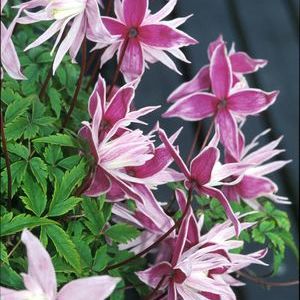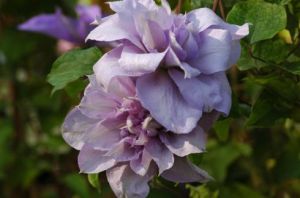
Clematis in my garden have been showing no signs of entrancing me with blooms in December. Then the other day I thought to look up. There, about 10′ off the ground up the gutter, Clematis ‘Duchess of Edinburgh’, a double June bloomer that sometimes reblooms with single flowers, had opened a somewhat tattered white flower, with second one on the way — maybe we’ll see that one in January. I had to hang out an upstairs window to get the photo. What a delightful surprise at the end of December!
Two other clematis I have are supposed to bloom in November and December, Clematis cirrhosa ‘Freckles’ (see photo below) and Clematis cirrhosa ‘Jingle Bells’. Jingle Bells, which is said to sport white bells in late fall/early winter, at least has the excuse of having been in the ground only a little over a year. Freckles, on the other hand, was planted in 2008 and has no such saving grace. My plant, which should bloom in late autumn, tends to throw a few blooms in July or August, then nothing in the fall. Though it’s evergreen with dainty fresh green leaves throughout the winter, I hanker for the flowers! In the photo below, my C. ‘Freckles’ demonstrates its disdain for bloom times by showing off with my Barberry ‘Helmond Pillar’ and Irish Bells in July! Geesh. You can see why it was named ‘Freckles’, though. I guess there’s still time — both Jingle Bells and Freckles are said to bloom from late fall through February. We’ll see.





